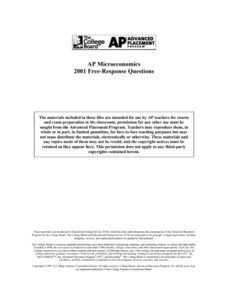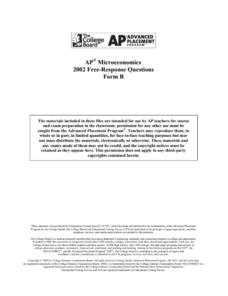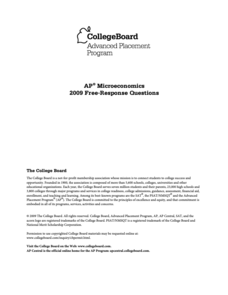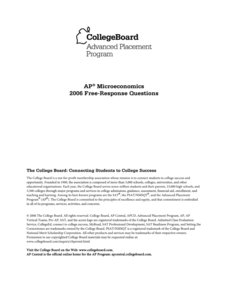Curated OER
Incentives, Profit and the Entrepreneur
Students discuss hypothetical problems associated with price and profit. They discuss the fairness of profit, how it should be measured, and the consequences of setting acceptable levels of profit.
Curated OER
Chapter 23: Pure Competition
Taking your young economists through the characteristics of four market models (Pure Competition, Pure Monopoly, Oligopoly, and Monopolistic Competition), this presentation uses both charts and graphs to illustrate the necessary...
Curated OER
Cartels and Competition
Students work together in teams to role-play a cartel. Using that information, they all produce the same commodity and they are trying to make as much profit as possible. Each group completes a balance sheet and calculate the amount of...
Curated OER
Graphing Perfect Competition
In this Graphing Perfect Competition worksheet, students analyze seven graphs, then must add to them or create their own based on directions.
Curated OER
Short-Run and Long-Run Competitive Equilibrium
Calculate profit and loss, plot on diagrams, and solve problems for given scenarios and variables in this 3-page worksheet. Students will obtain excellent practice after completing these pages.
College Board
2001 AP® Microeconomics Free-Response Questions
How does one factor in the social costs of a product? What factors influence price? Learners consider the question and others using authentic College Board materials. Other questions examine profits and competition in the market and the...
Curated OER
Perfect Competition
Young economists consider perfect competition, market demand, supply, and long-run equilibrium in this practical worksheet. There are eight multiple part questions to answer, real-world scenarios to consider, and graphs to complete.
Curated OER
Chapter 25: Monopolistic Competition and Oligopoly
Poring over the details and characteristics of monopolistic and oligopoly systems, these slides include charts, graphs, and key terms to help viewers truly grasp the concepts behind each market model. From budding economists to...
Curated OER
Competition and Market Structure
Students participate in a simulation in which some are buyers and some are sellers in a trading activity. They set their own prices and record transactions. Then they calculate who made the biggest profit. They discuss the results.
Curated OER
Oligopoly
Economics can be a competitive and, at times, devious subject. Learners work through a series of four worksheets to better understand oligopoly. Each sheet includes real-world scenarios, passages to read, graphs to analyze, and short...
College Board
2002 AP® Microeconomics Free-Response Questions Form B
The government catches a firm in the act of polluting. What will happen to the company's profits? Learners consider the question and others using authentic College Board materials. Other problem sets examine wages and labor and price...
College Board
2007 AP® Microeconomics Free-Response Questions
A monopoly gives a company exclusive rights to a market. What is the impact of that decision on the economy? Problem sets from College Board explore this question, as well as variables in labor markets and government regulations on profit.
Curated OER
Market Structures and Competition
Students review concepts related to market structures and competition. Using supply and demand, they identify what factors cause them to shift and analyze business downward facing demand curves. They compare and contrast the abilities of...
Curated OER
Business Practices and Competition
Students identify the costs and benefits of large corporations and monopoly industries. Using the internet, they discover how businesses use different types of exploitation to maximize their profits. They read two articles about plants...
Curated OER
Economics: Incentives, Profit, and the Entrepreneur
Students discuss both positive and negative economic incentives. In this lecture-based lesson, they examine a simulation about profiteering drug companies and what might happen if the FDA controlled drug production.
College Board
2009 AP® Microeconomics Free-Response Questions
Two stores are trying to decide where to put their new location to maximize profit? Young economists evaluate the question using authentic materials from College Board. Other queries involve evaluating the effects of government subsidies...
College Board
2017 AP® Microeconomics Free-Response Questions
How much corn does a farmer need to grow if he wants to make a profit? A prompt from College Board asks learners to put themselves in the boots of a farmer growing crops for the alternative fuel market. Additional prompts consider the...
College Board
2013 AP® Microeconomics Free-Response Questions
People often set off fireworks to celebrate. What is the cost of the annoyance of their neighbors? Economics help answer that question! Learners consider this problem, along with prompts on price and competition, using College Board...
College Board
2003 AP® Microeconomics Free-Response Questions Form B
How are monopolies and competitive firms similar and different? Scholars consider the question using authentic College Board materials. Other prompts consider supply and demand curves and the relationship between wages and output.
College Board
2016 AP® Microeconomics Free-Response Questions
How can a bakery—one of several in town—maximize its profits? A case study from College Board asks scholars to consider the question. Other practice queries examine the price and benefits of buying certain goods for one consumer and look...
College Board
2018 AP® Microeconomics Free-Response Questions
How much should Nirali study for her history and economics exams if she has a limited amount of time for both? Scholars consider opportunity cost in using this real-world scenario from College Board. Other questions include looking at a...
College Board
2006 AP® Microeconomics Free-Response Questions
Communities often experience a tug-of-war between a desire for open space and a need for development. How can governmental policy affect each side of the issue? Scholars consider the question, along with queries on pricing and...
Curated OER
In Your Own Backyard
High schoolers identify entrepreneurial opportunities that exist in their own community. From this information they determine possible market niches and identify potential businesses that could be started to meet the demands of these...
Miami University
Chapter Nine Worksheet: Monopoly
Advanced economics pupils analyze a series of graphs, data sets, and profit scenarios all related to monopolies and marginal revenue. They read through the background information, complete a graph using the data provided, and justify...

























